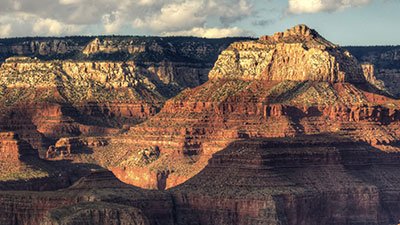
What’s Wrong with The Grand Canyon, Monument to an Ancient Earth?
A geology historian’s book review of The Grand Canyon, Monument to an Ancient Earth and why its arguments should fail to convince a careful Bible student.
In 2016, the book The Grand Canyon, Monument to an Ancient Earth: Can Noah’s Flood Explain the Grand Canyon was published by Kregel, a leading evangelical publisher. It openly rejects the truth of Genesis regarding the flood and the age of the earth and presents a seemingly water-tight refutation of the geological evidences cited by young-earth creationist geologists. This article is a very brief summary of my in-depth (50,000-word) critique of the book.
Why This Critique Is Needed
The critique is particularly warranted because the book has been endorsed by some of the most influential evangelical scholars of our time (including Wayne Grudem and C. John Collins) and has been regularly promoted at the annual meeting of the Evangelical Theological Society with the hopes of influencing evangelical seminaries. I expose the erroneous historical, philosophical, theological, and “biblical” arguments in the book (leaving the geological claims for creation geologists to address later—hopefully in the near future). I believe the book is very deceptive and will lead many evangelical scholars, pastors, laypeople, and students in the church astray as it undermines the truth and authority of Scripture.
It grossly distorts the history of this controversy and presents a deceptive description of the nature of science, particularly geology.
In my analysis of the non-geological parts of the book, I present and document the evidence to show the following. The authorship (eight professing Christians joined with three anti-Christians [agnostics]) is corrupt and contrary to Paul’s command in 2 Corinthians 6:14–18. It was funded in significant part by non-Christians and the anti-biblical Templeton Foundation1. It has been promoted to non-Christian geology professors to equip them to undermine the faith of Christians. It grossly distorts the history of this controversy and presents a deceptive description of the nature of science, particularly of geology. Most importantly, it displays a shallow and distorted handling of Scripture and frequently misrepresents young-earth creationists. As I show, its purpose is to openly convince Christians to accept millions of years but also to subtly convince them to accept biological (including human) evolution.
Conceptual and Historical Background
My analysis begins with a discussion of the critical difference between experimental (operation) science and historical (origin) science and the role of philosophical assumptions in the interpretation of the geological evidence.2 Hypotheses about the geological past and the biblical account of creation and the flood relate to the latter kind of science. The story of millions of years of earth history does not come from scientific experiments or radiometric dating but from naturalistic, uniformitarian, philosophical and religious assumptions used to interpret the geological evidence.
Then I give a brief history of the development of the geological theory of millions of years of earth history in the late 18th and early 19th centuries (based on my own PhD research).3 In my longer article I give substantial space to explaining the key geologists and assumptions behind the development of the idea of millions of years and define key terms like naturalism, uniformitarianism, laws of nature, and rates of geological processes. This is critical information to understand my arguments against the flawed and deceptive “scientific” reasoning and distorted history in the book.
The Book’s Foreword
In his foreword to the book, co-editor and agnostic geologist Wayne Ranney gives the false impression that old-earth geologists are just letting the facts speak for themselves. He certainly wants readers to think that young-earth creationists are pseudo-scientists and anti-science. I show what he does not reveal, namely, that the first two geologists who visited the Grand Canyon in the 1860s believed in millions of years before their brief visits and superficial observations. I also expose Ranney’s anti-biblical bias in one of his online lectures that paints young-earth creation as a novel 20th-century view rooted in unorthodox theology. He wants readers to believe that old-earth geology is solidly scientific and explains the Grand Canyon. But, as I show, his own 2005 book on the Grand Canyon reveals,
The canyon’s birth is shrouded in hazy mystery, cloaked in intrigue, and filled with enigmatic puzzles. And although the Grand Canyon is one of the world’s most recognizable landscapes, it is remarkable how little is known about the details of its origin. (italics added)
Ten years later, the authors of The Grand Canyon, Monument to an Ancient Earth want their readers to believe that old-earth geologists have largely explained the canyon, having cleared away the hazy mystery and solved the enigmatic puzzles.
Chapter 2: “Biblical” Arguments
Chapter 2 is where two of the Christian geologists present their “biblical” arguments for concluding that Noah’s flood was a large flood in the Mesopotamian Valley of the Tigris and Euphrates rivers (modern-day Iraq). Before analyzing their very shallow arguments for a local flood, I briefly lay out 22 biblical evidences that the flood was historical, global, yearlong, and catastrophic. The Scriptures could not be clearer.4
Before getting into the biblical arguments, these Christian geologists give a distorted history of geological science. They present the myth that the idea of millions of years was the result of many years of careful geological observations. Following the apostate Seventh Day Adventist, agnostic historian of science Ronald Numbers, they try to persuade readers that flood geology is rooted unorthodox theology—in the writings of early 20th century Seventh Day Adventist pseudo-geologist, George M. Price.
But as I show, they are the ones who are engaged in a selective literal reading of Genesis because they have left out most of the biblical evidence for the global flood that I refer to above.
Next, they briefly discuss four “basic principles” of flood geology, which they say “are based in a selectively literal reading of Genesis” and are “some of the most important scriptural interpretations” in defense of flood geology. But as I show, they are the ones who are engaged in a selective literal reading of Genesis because they have left out most of the biblical evidence for the global flood that I refer to above. In this section on “basic principles,” strawman arguments against flood geologists abound, and I expose them regarding the age of the earth and date of Noah’s flood, the source of water, and the extent and geological results of it, as well as regarding the fall of Adam in sin.
Six biblical “Problems” with Flood Geology
In this section, the authors raise six “biblical” objections against the global flood. First, regarding biblical interpretation they make false charges against young-earth creationists as they confuse interpretation and translation of the biblical text. They also try to say that young-earthers do not follow the principles on hermeneutics developed by the International Council on Biblical Inerrancy, even though, as I show, these old-earthers give no evidence that they hold to the inerrancy of Scripture.
Second, they contend that the Hebrew word eretz doesn’t mean the whole earth in Genesis 6–8 but rather means only land visible to the horizon of the observer (i.e., a small part of the Middle East). Third, they argue that the Hebrew word col doesn’t literally mean “all” in the flood account, but is only a relative term meaning all in a localized area. Fourth, they attempt to argue from the Hebrew that the floodwaters did not literally “cover” all the high mountains under heaven (as all Bible translations render Genesis 7:19–20) but merely “drenched” the mountains, and therefore these verses mean that “water rose to a depth of twenty feet against the mountains.” I easily and thoroughly disproved these shallow and fallacious arguments.
Their fifth “problem” attempts to defend their belief in millions of years of animal death, disease, predation, and extinction before Adam’s fall. Their one-paragraph argument is totally inadequate to rebut even a short creationist defense of our view,5 much less a thorough defense.6 The myth of millions of years not only contradicts the Bible’s teaching about an original “very good” creation and the impact of the fall and curse on the whole creation, but it also assaults the very character of God and undermines the gospel of Jesus Christ. Christians need to abandon shallow thinking on this vital issue.
Sixth, their last argument against the global flood deals with the location of the Garden of Eden. Yet again, the geologist authors display an appallingly bad handling of Scripture and a superficial treatment of the geography of the present Middle East.
Given the lack of careful interpretation and examples of Scripture-twisting in the biblical arguments of these two geologists, one has to wonder if the prominent evangelical Bible scholars (Wayne Grudem, C. John Collins, and Ken Keathley), who endorsed this book, carefully read this chapter.
The Concluding Chapter
The concluding chapter of the book is three pages. As I show in my critique of earlier sections of the book, they continue to deny that the debate of the age of the earth involves a worldview conflict. Here too I expose misrepresentations of creationists and deceptive statements about “data,” “laws of nature,” and “interpretation” of the evidence. They also continue to confuse operation science and origin science.
I also demonstrate their erroneous understanding of what theologians call “general revelation.” The old-earth authors of this book think this is the consensus view in science about origins merely gleaned from an unbiased study of nature. They use that “general revelation” to interpret (or ignore or twist) the special revelation (the propositional truth statements) of Scripture to try to make it fit with evolution and millions of years. But Scripture and orthodox theologians have always taught that nature alone reveals not the origin and history of the creation but rather reveals infallibly to all people in all times and places the existence and at least some attributes of the Creator. Hence idolaters (including atheist and agnostic scientists) are without excuse for their unbelief and rebellion against God (Romans 1:18–20).
More and more evangelical theologians and other leaders are compromising with not only millions of years but also theistic evolution, even doubting or denying the existence of a literal Adam and historical fall.
Finally, the authors say, “Does it matter? It certainly does! Truth always matters!” I totally agree. But the truth of God’s Word matters supremely. More and more evangelical theologians and other leaders are compromising with not only millions of years but also theistic evolution, even doubting or denying the existence of a literal Adam and historical fall. As a result, we are witnessing a mass exodus of young people from the church, and the millennials who do stay reveal much moral and doctrinal confusion.7 And because most people in the Western world think that science has proven Genesis 1–11 is mythology, they have become increasingly resistant to the gospel, which is rooted in the foundational truths of those opening chapters of the Bible.
The age of the earth and the flood matter enormously! What is at stake is the supreme authority and truth of God’s Word and the gospel itself. The Grand Canyon, Monument to an Ancient Earth is an assault on that truth and authority, is deceiving many, and is destructive to the church’s witness and credibility. Therefore I encourage readers to examine my longer critique. You will be strengthened in your confidence in God’s Word and sharpened in your ability to teach others (especially your children and grandchildren) and to defend the truth.
Footnotes
- Melissa Skinner, “Funding Darwin in the Church,” Answers Magazine 12, no. 3 (May-June 2017): 70–77, https://answersingenesis.org/church/funding-darwin-church/.
- For a brief explanation of the difference between these two broad categories of science, see Ken Ham and Terry Mortenson, “Science or the Bible?” Answers Magazine 2, no. 3 (July–September 2007): 22–26, https://answersingenesis.org/what-is-science/science-or-the-bible/.
- See my DVD lecture “Millions of Years: Where Did the Idea Come From?” or my book The Great Turning Point: The Church’s Catastrophic Mistake on Geology—Before Darwin.
- Terry Mortenson, “Noah’s Flood: A Historical, Global Catastrophe,” https://answersingenesis.org/noahs-flood/, 2020 October 10.
- Ken Ham, “The ‘god’ of an Old Earth,” https://answersingenesis.org/who-is-god/god-is-good/the-god-of-an-old-earth/.
- Terry Mortenson, “The Fall and the Problem of Millions of Years of Natural Evil,” https://answersingenesis.org/theory-of-evolution/millions-of-years/the-fall-and-the-problem-of-millions-of-years-of-natural-evil/.
- See Ken Ham, Already Gone, about the 20-year-olds who grew up in the church but have now left the church, most of whom are likely never to return. See Ken Ham, Jeff Kinley, and Britt Beamer, Ready to Return?, about the 20-year-olds who grew up in the church and are still in the church, but are significantly confused and compromised both morally and doctrinally.
Recommended Resources

Answers in Genesis is an apologetics ministry, dedicated to helping Christians defend their faith and proclaim the good news of Jesus Christ.
- Customer Service 800.778.3390
- © 2024 Answers in Genesis





